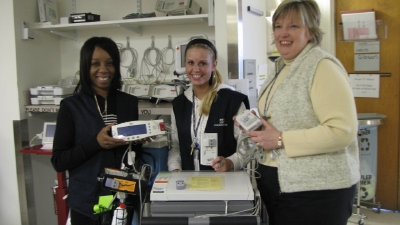New Technology Helps to Locate Equipment for Nurses

From left, unit coordinators Shemica Carr and Megan Gleeson and Tower 14 Operations Supervisor Patricia Schoolcraft hold up some of the equipment now tagged with RFID chips.
Since February, BWH has been tracking the whereabouts of more than 4,000 pieces of equipment through RFID technology to ensure patient care staff have the equipment necessary for delivering care. This is especially crucial as BWH accommodates a seasonal surge of inpatients.
“We went unit to unit, placing the RFID chip on equipment so we can track it and make sure it’s available to nurses when they need it,” said Leo Buckley, director of Business Services for Patient Care Services and a member of the SWAT Surge Committee. “This committee is taking a hard look at our inventory of equipment so that we can provide the safest environment for patients and caregivers.”
That equipment includes PCA pumps, Alaris pumps, defibrillators, bladder scanners and telemetry equipment.
The roll-out of RFID, or radio-frequency identification, technology throughout the hospital in February is one crucial means of ensuring the availability of equipment. The Surge Committee also purchased 12 more PCA pumps and rented ten DASH monitors, which often are needed by patients in the ED before they can be admitted to inpatient floors.
An equipment technician also was hired to work the night shift and gather equipment from the floors, clean it and make it available to the OR, PACU and ED first thing in the morning. “This has been a tremendous help,” Susan Sabino, manager of the Equipment Pool in Central Transport, said. “Equipment technicians are the ones who need to fill the equipment requests of staff, and they’ve found that more equipment is available now, allowing them better to meet the needs of nurses and others.”
Nurses in areas such as the PACU are noticing improvements. “PCA pumps and Alaris pumps have been more available to us in the PACU recently,” said Ellen Sullivan, BSN, RN, CPAN, a nurse in-charge in the PACU. “Previously, we experienced a shortage of both types of pumps.”
The efforts of staff nurses on the inpatient floors are needed to ensure that equipment remains available. When a pump is discontinued on a patient, all tubing must be removed so it can be cleaned and delivered to the pick-up area.
“Staff have sometimes been uncomfortable putting equipment in the clean utility area for pick up because they are afraid it won’t be available again if they have a patient on the unit who suddenly needs it,” said Kim Ternavan, MS/MBA, RN, nurse manager of Tower 7AB. “But if everyone puts available equipment back into the pool, it will generate a better supply to fill staff and patient requests. However, when there are periods of increased patient census or high acuity, the tracking system has been instrumental in locating available equipment to support patient flow and care needs.”
When equipment is not being used on a floor, staff can request a pick-up electronically through BICS. Use the Utilities menu and then select Transport to find the equipment pick-up form. This allows equipment technicians to make sure it’s available for patients.